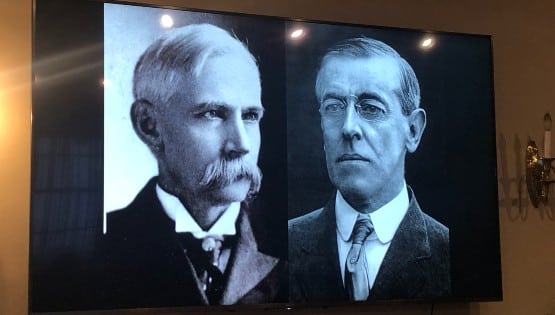
Upon admission, the bald eagle was thin and showing classic symptoms of lead toxicity. A blood test confirmed that the bird was suffering from lead toxicity – at levels too high for the Center’s lead analyzer to read.
The Center’s lead-tester reads levels up to 0.65 parts per million. Studies have shown that lead levels of more than 1 ppm are lethal or linked with damage or destruction of the optic nerves.
The Center immediately started chelation treatment [to cleanse the lead from the bird]. The eagle is also receiving supplemental oxygen.
The Jan. 11 eagle is the third bald eagle admitted to the Center with lead toxicity in the past two weeks. On Dec. 30, a bald eagle with lead toxicity was admitted from Fauquier County; that eagle died on Jan. 1. Also on Jan. 1, the Center admitted a bald eagle from Chesapeake with high lead levels. That eagle has completed its first round of chelation therapy at the Center.
Each year the Center treats about 2,500 wildlife patients from all across Virginia, including bald eagles, and an alarming number of eagles admitted for care display signs of lead poisoning. In 2011, for example, the Center admitted 36 bald eagles – six of these showed signs of lead toxicity, and another 15 had measurable levels of lead.
Routine radiographs show that many of these eagles are exposed to the highly toxic metal by ingesting lead shotgun pellets or bullet fragments. The eagles ingest these fragments while scavenging animals that have been shot but not recovered by hunters, or by feeding on the entrails of game animals, like deer, which have been harvested and “field dressed.”
Field dressing is the practice of removing the internal organs from animals harvested for human consumption, in order to preserve the quality of the meat. Typically, these entrails are simply left on the ground. Even the smallest bit of lead from bullets or shot left in these internal organs can quickly disable or kill a bird like a Bald Eagle when it feeds on these remains.
For this reason, the Wildlife Center is urging hunters voluntarily to either switch to bullets and shot which do not contain lead, or to bury or cover the animals or animal parts left in the field.
“Here’s a somewhat belated New York’s Resolution for Virginia hunters,” Ed Clark, president of the Wildlife Center, suggested. “Please switch to non-lead ammunition for hunting, or take a few extra minutes to cover and dispose of carcasses and animal parts that may contain lead fragments. The sickness or death of even a single Bald Eagle is just too high a price for human negligence or laziness.”
According to Clark, for decades the ingestion of lead shot resulted in deaths of staggering numbers of ducks, geese and swans. “Prior to a nationwide ban on the use of lead shot for waterfowl hunting, an estimated four-million ducks and geese died annually as a result of swallowing lead pellets that had been fired over wetland areas by waterfowl hunters. The birds would find the pellets as they sifted through bottom sediments looking for food. A single pellet that lodges in the digestive tract of a bird can be fatal,” Clark stated.
In an effort to curb these losses, a prohibition on the use of lead shot for waterfowl hunting was imposed in 1991 by the federal government. The use of steel and other lead-free materials for the manufacture of shot has dramatically reduced the amount of lead in wetland habitats.
Clark drew a sharp contrast between the waterfowl deaths and those of the eagles. “The eagles are not randomly picking up loose pellets from their environment, as did waterfowl. The eagles are getting the lead by eating other animals, or parts of other animals — ones that have been shot.” Often when hunters shoot upland game, such as doves, rabbits or squirrels, the downed animals are very difficult to find. State law requires hunters to make a good faith effort to recover any game animal that has been killed or wounded in the course of legal hunting. “Unfortunately, many of these animals are never found. They’re simply left where they fall, creating an attractive but deadly meal for scavengers,” Clark stated.
It is also routine for farmers and “varmint hunters” to shoot nuisance animals, such as groundhogs, and deliberately leave the dead bodies out for scavengers to eat. However, these shot-filled bodies are toxic time-bombs. The tragedy of it all is that these poisoning deaths are almost totally avoidable, Clark noted.
According to Clark – a gun collector, avid shooter, and lifelong hunter – there are now alternatives to the use of lead-based ammunition for hunting. “Several companies are now manufacturing bullets made of solid copper. They are ballistically identical to lead, and are every bit as effective.” While Clark still uses lead bullets for target shooting, he has switched entirely to copper bullets for hunting. “There is a lot of false information out there suggesting that copper bullets are not as effective as lead. The bottom line is that, if you miss your quarry, or fail to bring it down with a single shot, it is not the bullet’s fault!”
Clark points out that those hunters who refuse to give up their traditional lead projectiles can still help eliminate the risk posed by lead shot by simply burying or properly disposing of animal carcasses or entrails. Covering the remains or discarded parts of shot animals with brush or sticks could largely eliminate access to these toxic morsels by avian scavengers, particularly birds like eagles and other raptors. When eagles and other scavenging birds find and eat these carcasses, they swallow the bullets and lead pellets along with everything else. Unfortunately, even tiny particles of lead can become lodged in the digestive tract; digestive fluids leach the heavy metal into the blood stream and body tissues, affecting the nervous system and internal organs. Affected animals may appear lethargic and weak and are unable to stand or fly, even though there may be no outward signs of injury.
The Center recently posted on its website a position paper on lead toxicity in raptors – at
www.wildlifecenter.org/wp/2012/01/wildlife-conservation-issues/
Anyone finding an injured eagle or other wild animal is urged to contact a Conservation Police Officer or the Wildlife Center immediately. Often, an animal’s chance of survival depends upon the speed with which it is presented for treatment. This is especially true in poisoning cases.
“Losing a bald eagle is a really sad event,” said Clark, “especially when the cause of the bird’s death is so preventable. We can only hope that these tragic cases will remind everyone that bullets and shotgun pellets can kill twice.”
The Wildlife Center of Virginia is a non-profit teaching and research hospital for native wildlife, located in Waynesboro. The Center’s goal is to rehabilitate these wild animals and return them to the wild. Since its founding in 1982, the Center has cared for more than 59,000 wild animals, representing 200 species of birds, mammals, reptiles, and amphibians. The Center’s public education programs share insights gained through the care of injured and orphaned wild animals, in hopes of reducing human damage to wildlife. The Center trains veterinary and conservation professionals from all over the world and is actively involved in comprehensive wildlife health studies and the surveillance of emerging diseases. Additional information about the Wildlife Center is available at www.wildlifecenter.org.










